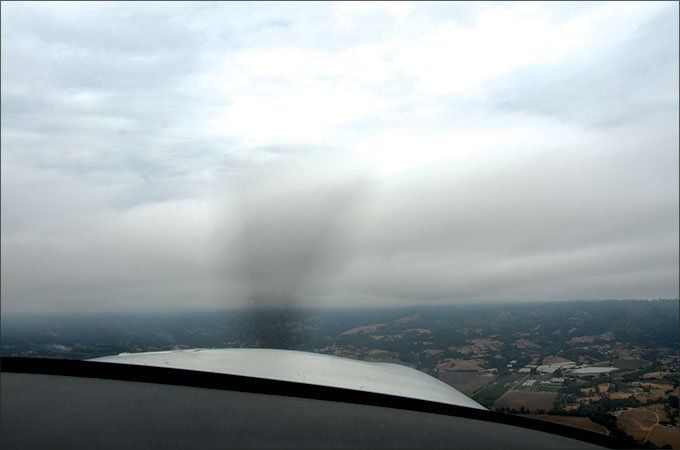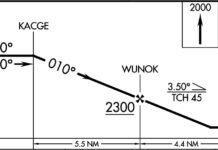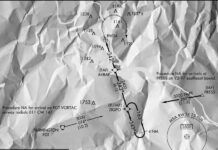There are actually two pieces to this. There’s the clearance to maintain altitude “VFR-on-top” itself, but there is also the variation mentioned in “Tame the Fog Monster” last month, the IFR departure to VFR-on-top. Both are useful tools that deserve a closer look.
Since VFR-on-top is the key piece, we’d better define it. In the simplest form, think of VFR-on-top as clearance requested by you in lieu of a hard altitude, where you can pick your VFR altitude while maintaining VMC on an IFR flight plan. There are other nuances we’ll get into below, but VFR-on-top as an IFR altitude assignment is the gist of it.
Your IFR Escape Plan
Given the fickle nature of marine layers, I’ve often expected to depart VFR only to be faced with a low ceiling. Rather than taking the time to file a full IFR flight plan, the “IFR to VFR-on-top” clearance solves the need. It’s a true IFR clearance that allows an aircraft to make an IFR climb through a cloud layer or other obscuration to VFR conditions. You typically don’t have to file in the normal sense. Usually all it takes is a quick request to the appropriate ATC facility.
Now, when I say “usually all it takes” I’m referring to a location that’s not horribly busy. If you’re departing a Class C airport that lies in the shadow of an overhanging Class B, you might be better off both from a clearance availability standpoint and for time efficiency to file IFR as you normally would and just cancel—if you wish—when you reach suitable conditions.
Once you get that clearance and launch through the muck, upon reaching VMC there are three options. You can cancel IFR service and continue VFR with flight following, with the normal “workload permitting” caveat. Or, you can cancel ATC services entirely and continue VFR. But if you want the benefits of IFR but no altitude constraints there is the option of continuing “VFR-on-top” as your only altitude clearance.
By the way, don’t be confused with “VFR over the top.” This is simply a VFR flight that departs, cruises and lands in VMC, but might be flying over an undercast en route.
How To
When you’re ready to depart through an overcast to known VFR conditions above the overcast (see sidebar on SkewT), ask for “IFR to VFR-on-top” and state the desired direction of flight or destination. This will typically elicit one of two basic clearances.
The first is simply a clearance to climb to VFR-on- top. “Climb to and report reaching VFR-on-top. Tops reported one thousand eight hundred.” or “…No tops reported.” It would be unusual for the controller to give you an unlimited clearance like that without knowing the tops, so the clearance may contain restrictions.
If the controller doesn’t know the tops or there is another need to restrict you in some way, such as for traffic avoidance, you may get some restrictions in the clearance, including a clearance limit. “Cleared from the Watsonville airport to the Salinas VOR via direct. Climb to and report reaching VFR-on-top. No tops reported. If not on top by five thousand, maintain five thousand and advise.” As always, your clearance may or may not contain specific departure instructions such as an obstacle departure procedure. If not, be sure to choose a safe departure routing.
Note that your clearance limit is a VOR. This is common, particularly if the controller knows the weather at the VOR is VMC and clear of the layer you were trying to escape.
Once you reach VMC, notify ATC that you’re on top and cancel IFR if you wish. If you want to remain on your IFR clearance, simply report reaching VFR-on-top and you’ll receive the follow-up clearance, “Maintain VFR-on-top.” If you reach the clearance altitude limit and are still IMC, advise ATC and together you can work out your Plan B.
If you aren’t certain that you can climb to VFR conditions by a reasonable altitude you’re probably better off filing a full IFR flight plan that includes a destination—maybe a nearby airport or even your departure airport—so you’ll have a destination if you lose communications.
If you go NORDO (FAA jargon for “NO RaDiO”) at any point and you’re in VMC, maintain VFR, squawk 7600 for one minute to indicate communications loss, then squawk 1200 to let them know you’re maintaining VFR. Land at the nearest suitable airport—I’d prefer a non-towered airport—and contact ATC.
If you’re still IMC and lose your radios, the IFR lost communications rules may not help much, primarily because your clearance limit is probably a VOR or some other convenient fix, not an airport. At this point you’re going to have to use your judgment.
I’d squawk 7600 for one minute to notify ATC I’m experiencing lost communications, and then 7700 to indicate that I’m declaring an emergency. In this order I would then either go to the nearest airport with VFR conditions, the nearest airport with weather conditions conducive to a low-stress instrument approach, or finally, the nearest airport with an acceptable approach of any type.
Remember, though, you must have the weather and approach information to make that emergency decision before you take-off. Once you have a complete loss of communications it may be too late to figure out the weather at your various airport options. Don’t forget satellite weather if you have it. It may not be current, but it’s better than nothing.
If your plan is only to reach VMC with the intent of continuing VFR, one thing that might help get a quicker clearance is to tell ATC during the initial request that you’re planning to cancel services once reaching VMC. That reduces their ongoing workload and might expedite the clearance. If you want flight following, ask for it during your initial request. If you’re planning to use VFR-on-top for the remainder of your flight, it’s better to file a full flight plan with the complete routing and the note “VFR-on-top” in the remarks section rather than trying to get a pop-up IFR clearance.
As you climb through the tops to VMC keep in mind that the natural inclination is to cancel IFR as you break into the clear. Don’t. You must maintain the basic VFR cloud clearance requirements of 91.155. For most airspace this is 1000 feet above the clouds, so if you can’t remember the specifics, note the altitude of the cloud tops and make certain that you’ve climbed at least an additional 1000 feet before canceling IFR. If ATC didn’t know the tops or they’re different than ATC stated, give the next pilot a leg up and provide ATC with a bases and tops report.
VFR-On-Top
If you decide to continue VFR-on-top, even though it’s officially an IFR clearance you are responsible for flying at the correct VFR altitudes per 14 CFR 91.159. However, you’re free to choose and change to any VFR altitude as long as you don’t go below the MEA. In addition, you’re responsible for flying with the appropriate cloud clearance and inflight visibility. You also have the primary responsibility for traffic avoidance and wake separation, although ATC will typically provide assistance as they do for flight following.
The flip side is the necessity to also operate under IFR regulations like minimum IFR altitudes, following your assigned route, required position reporting, adherence to all clearances, etc. Normally you’re also requested to give ATC at least a one minute warning before changing altitude so they can coordinate with other sectors or aircraft.
So, with all the extra restrictions, why choose VFR-on-top? It provides most of the benefits of IFR services, but with potentially greater flexibility, especially in terms of altitude. You can request VFR-on-top in lieu of a specific altitude assignment on any IFR clearance.
A pilot might choose VFR-on-top when IMC en route in or near the cloud tops, icing conditions or any time you just need a little more altitude flexibility. IFR at, say, 7000 could be in the tops and icing, but VFR-on-top at 7500 could be all you need. A few hundred feet can be enough to make the difference, so you don’t need a 2000 foot change to the next IFR altitude.
You might prefer a slower descent than you can get from ATC—you or your passengers have ear or sinus problems or to avoid engine shock cooling, for instance—a VFR-on-top clearance can allow you to choose a descent point and rate to suit your needs. You just can’t descend below the MEA.
I’ve used a VFR-on-top clearance to get around an area of cloud buildups. I was tired of waiting for a clear second on a frequency already overwhelmed with deviation requests. Getting VFR-on-top with a block altitude and the notification that I would be deviating around buildups allowed me to deviate and climb or descend within the block altitude as necessary. I still had to maintain VFR cloud and visibility requirements, but being responsible for my own traffic separation made the controller’s job easier and he gave me more freedom to deviate. You might not always get this much freedom, but you certainly won’t if you don’t ask.
In general ATC is more inclined to allow flexible routing, especially in less busy airspace, because the pilot has responsibility for traffic avoidance. There are no guarantees, of course, but when VFR-on-top it may be possible to get a routing that wouldn’t be available at an IFR altitude. This can even come in handy if you’re flying over a scenic area you’d like to see a bit more closely.
One more benefit of being VFR-on-top is that since you’re still on an IFR flight plan, you can’t get dropped like ATC sometimes does with flight following. You might file VFR-on-top if your destination is in busy or complex airspace. This allows you to relax for the majority of the trip and when you’re nearing the destination it’s very easy to get fully back into the IFR system by simply telling ATC that you’re canceling VFR-on-top and requesting a specific IFR altitude assignment.
Good Stuff
Just because it’s called “on-top” doesn’t preclude operations below or between layers or even in severe clear weather. The only requirement is that the weather at least allows you to maintain the VFR cloud clearance and visibility requirements of 91.155. Also, an “on top” clearance isn’t available in Class A airspace and in selected restricted areas.
There are a few tricks in the IFR toolbox that are seldom used, and VFR-on-top is one. However, like others, it has a place when properly applied. An IFR to VFR-on-top clearance can be the easiest way to escape an airport that’s in IMC but with VMC nearby. Once underway, VFR-on-top permits more flexible en route options with the ability to quickly resume full IFR as conditions, the destination or your psyche may require, including getting sequenced into your turn for that ILS to mins at your destination. VFR-on-top is a useful tool to keep in your bag of tricks.
Briefing with SkewT
When planning a flight, I look for cloud bottoms, cloud tops, layers, freezing level, wind direction and speed. SkewT charts (rucsoundings.noaa.gov)are one of my favorite weather briefing tools. They are computer generated forecasts for airport locations, derived from weather balloon soundings.
I can tell at a glance where the layers are and where it’s clear. With the added benefit of freezing level and winds, this offers a wealth of valuable information when planning any departure.
Projections over several hours, help me confidently plan IFR flights, or cancel with better understanding of the unfavorable conditions aloft. I use SkewT with other weather information (NOAA’ ADDS, Satellite, Radar, DUAT(S) Briefings, etc.), to get a total picture of the weather before making my go/no-go decision and before making my final routing choice.
The red line shows temperature and the blue line shows dew point. Where these lines converge (from bottom-up) shows the cloud bases and where they diverge shows cloud tops. The diagonal scale is temperature. Just follow the zero degree line up to the current temperature for freezing level. Wind speed and direction are shown on the right. —George Flutas, CFII
The central California coastal overcast requires Joe Shelton to request IFR to VFR-on-top far more often than he’d like.





